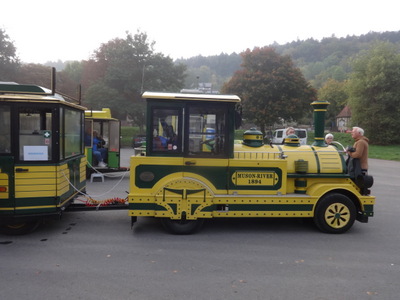
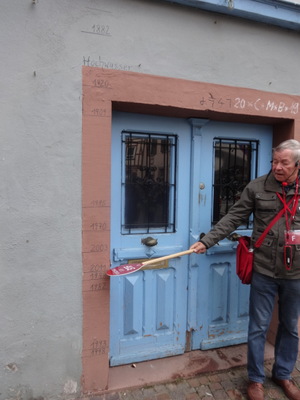 Instead of boarding the usual buses, we were taken from the ship into the town aboard this picturesque little tourist train.
Instead of boarding the usual buses, we were taken from the ship into the town aboard this picturesque little tourist train. Saturday, 8 October, Wertheim, Germany (without modern aristocracy)
Written 9 March 2023
On this day, we were scheduled for an 8-hour excursion called "Modern Aristocracy," during which we got to travel to an actual castle, still occupied by its aristocratic family, to learn all about keeping such an estate up and running in today's world and to have lunch at the castle. The lady of the house is actually godmother to one of Viking's ships. But the evening before, we found a memo in our staterooms saying that because half of the Kosttheim lock was down for repairs, that excursion would have to be skipped so that we could snag a place in line to get through that lock's twin, now doing double duty, in order to keep the rest of the trip on schdedule. Drat.
They refunded our money of course and let us sign up for the morning's included Wertheim walking tour instead. The alternatives were the "castle hike" and Wertheim by bicycle (Jan went for that one).
The ship moored in Wertheim about 8 am, and half an hour later, we (and the castle hikers) left for our morning's excursions. The bikers took off 15 minutes later, and immediately afterward, the ship cast off and headed downstream toward Freudenberg, where it would pick us up later.

 Instead of boarding the usual buses, we were taken from the ship into the town aboard this picturesque little tourist train.
Instead of boarding the usual buses, we were taken from the ship into the town aboard this picturesque little tourist train.
We're now officially out of Bavaria; Wertheim is is the most northerly town in the state of Baden-W&umul;rttemberg. It's another of those little towns built on the peninsula formed where one river flows into another—in this case, the Tauber into the Main—so it's another town subject to epic flooding. At the right here is the usual flood gauge. The guide is pointing to the most recent, 2011. The highest dated mark on this wall is 1882 (well above the door frame), but there's an unmarked line above that, which is 1764. But even that's not the highest one—the one for 1892 is out of the photo, above the gutters of the house.
Note also on the door lintel above the guide's head, another of those codes indicating how recently the household contributed money to the carolers at Christmas.
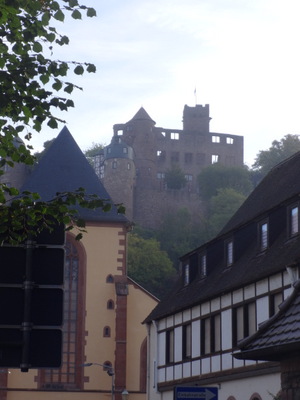
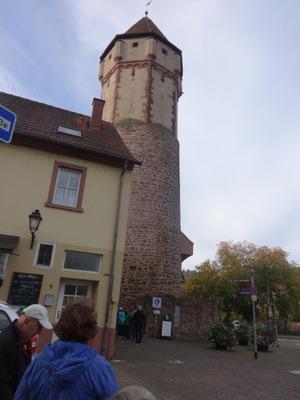 Behind the town, farther up the peninsula, is a hill (the town borders on both the Odenwald hills and the Spessart range. Two thousand years ago, the border between Germanics and the Romans was here; Wertheim still belonged to the Germanic tribes. By 700 AD, fishermen and shipbuilders were established here on the Tauber. About the year 1000, I think the guide said, the local dukes got permission from the emperor to build a castle on the hill. With it came the right to tax whatever came along the river; as elsewhere, the traders had to stay for 3 days before passing onward. The castle is ruin now (left-hand photo).
Behind the town, farther up the peninsula, is a hill (the town borders on both the Odenwald hills and the Spessart range. Two thousand years ago, the border between Germanics and the Romans was here; Wertheim still belonged to the Germanic tribes. By 700 AD, fishermen and shipbuilders were established here on the Tauber. About the year 1000, I think the guide said, the local dukes got permission from the emperor to build a castle on the hill. With it came the right to tax whatever came along the river; as elsewhere, the traders had to stay for 3 days before passing onward. The castle is ruin now (left-hand photo).
The town was surrounded by a wall with 18 gates and 18 towers; only a few towers remain today. The guide mentioned two, a pointed tower and a leaning tower; I think this (at the right) is the pointed one). The round part dates from the end of the 12th century; its walls are five feet thick.

 Bedrock is 35 feet down here, the rest is sandy silt, alarm resulted when the leaning tower (the one at the left here, I think was found to have leaned an extra inch. In 2010, they started reconstruction, installing titanium pilings underneath, and according to laser measures, it hasn't leaned any more since then.
Bedrock is 35 feet down here, the rest is sandy silt, alarm resulted when the leaning tower (the one at the left here, I think was found to have leaned an extra inch. In 2010, they started reconstruction, installing titanium pilings underneath, and according to laser measures, it hasn't leaned any more since then.
The highest tower (one of the two here, but I'm not sure which) is 125 ft high. They used to watch for fires from that tower, so the town has never had a major fire.
The lower part of one of the towers (again, I'm not sure which, though the 12th-century base of the pointed tower looks like a good candidate) was used as a prison. It was windowless and doorless; prisoners, like debtors, drunkards, and nagging women, were lowered into it through a hole in an upper floor.
During WWII, Nazis lived inside one of them.
In the photo at the right is a nice row of attractive old house. In front of them is a mobile fish market—a small market was in progress in the central square.
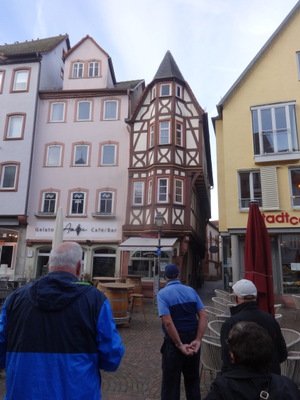
 At the left here is a particularly picturesque narrow half-timbered house.
At the left here is a particularly picturesque narrow half-timbered house.
And at the right, the proprietor has left a gap in the stucco facade of his building to flow the date underneath: it could say 1577, but the first figure could also be a J for "Jahr" (year), making the date 577!
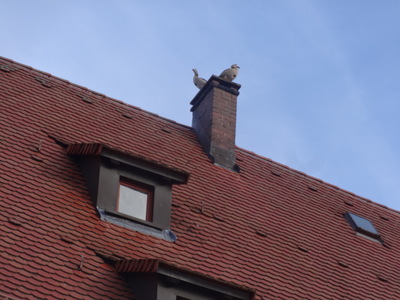
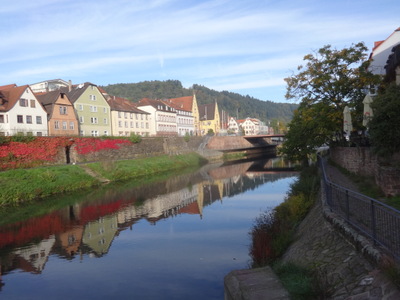 We walked right across the peninsula, passing on the way this house with, of all things, a pair of Egyptian geese perched on its chimney.
We walked right across the peninsula, passing on the way this house with, of all things, a pair of Egyptian geese perched on its chimney.
The Tauber is the smaller of the town's two rivers, but it's the one that causes the floods. When the Main is full and raging, the Tauber can't empty into it (no room!), so it backs up and floods the town. Here, it's just flowing innocently by. The red vines on the wall across the river are Virginia creeper, just like we have in Tallahassee. The bridge is actually on lifts so that it can be raised to let ships under when the water is high. The Tauber is about 70 miles long, and starts in Rothenberg. On the other side is a railway line, built 150 years ago and still in use.
Other things the guide told us:
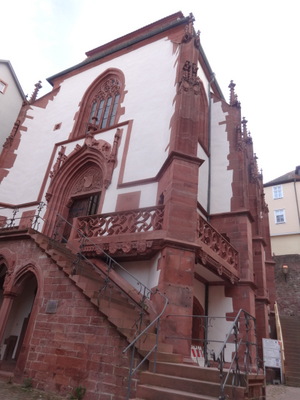
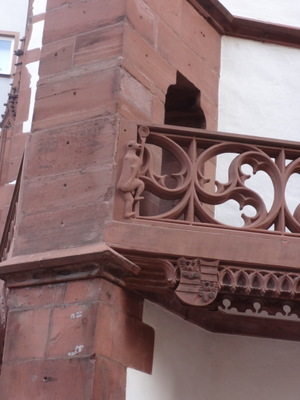 At this point, the guide gave us a choice. We could start our free time now, or we could come with him into a little meeting room in St. Killian's to hear a little about local Jewish history first. We opted for the lecture.
At this point, the guide gave us a choice. We could start our free time now, or we could come with him into a little meeting room in St. Killian's to hear a little about local Jewish history first. We opted for the lecture.
To get there, we climbed this staircase. At one corner, on the stone bannister, was this figure of a monkey holding a mirror representing, we were told, time.
Here's a sampling of what he told us.

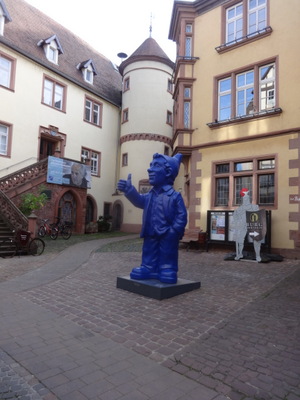 We started our free time by visiting the shop of the glassblower who did the onboard demonstration the night before. Here's not a very good photo of a small sample of his wares. A specialty of his "sparrows," plump little solid glass paperweights in the shape of birds, but the shop offers a huge variety of vases, jars, art, bowls, cigarette holders, jewelry, and ornaments.
We started our free time by visiting the shop of the glassblower who did the onboard demonstration the night before. Here's not a very good photo of a small sample of his wares. A specialty of his "sparrows," plump little solid glass paperweights in the shape of birds, but the shop offers a huge variety of vases, jars, art, bowls, cigarette holders, jewelry, and ornaments.
A few steps away, just off the market square, is this whimsical guy. According to the plaque at his feet, he is the "Wertheim Optimist," by Otto Hörl, 2022.

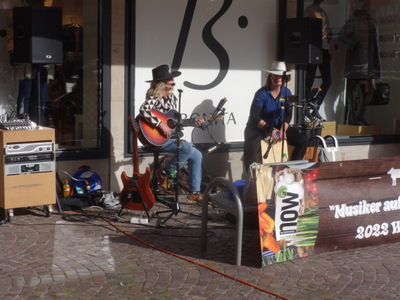 Also on the market square was a souvenir shop that spilled out onto the street. This rack displays fridge magnets bearing phrases like "I think I spider," "I wish you what," "Now we have the salad!," "I see black for you," "I break together!," "What for a juice-shop!," and "That makes me foxdevils-wild." Many others were in German, but they didn't seem to be translations of these English ones. I haven't a clue.
Also on the market square was a souvenir shop that spilled out onto the street. This rack displays fridge magnets bearing phrases like "I think I spider," "I wish you what," "Now we have the salad!," "I see black for you," "I break together!," "What for a juice-shop!," and "That makes me foxdevils-wild." Many others were in German, but they didn't seem to be translations of these English ones. I haven't a clue.
But the highlight of the day, and perhaps of the entire cruise, was this musical duo set up at the bottom end of the square. The banner in front of them seems to say "Musicians in the Market"; I gather they were there as part of a concert series that played on market days. In any case, they were fabulous! I went off for a little while, because there was a small side street I wanted to explore, but I soon came back, and David stood there, riveted, for the entire rest of our time in Wertheim. They might possibly be called "TimeBack," but I can't seem to find much else about them. They played mostly American music (a bunch of Elvis tunes, among many others), in both English and German, and boy were they good!

 Then it was back to the rendezvous to take the little trains back down to dockside. The ship was gone, but a fleet of buses stood ready to take us and the hikers down the river to catch up with her at Freudenberg (past these handsome cliffs). We got there just as the Vidar was tying up and putting out the boarding ramp; the bicyclists, who had traveled the 20 miles on the tow path, waving to the Vidar as she overtook them, were taking off their helmets. We all trooped up the ramp into the ship, and by the time we had dropped off our stuff in our cabins and returned to the dining room for lunch, she had cast off and was headed downstream again, in hurry-up mode.
Then it was back to the rendezvous to take the little trains back down to dockside. The ship was gone, but a fleet of buses stood ready to take us and the hikers down the river to catch up with her at Freudenberg (past these handsome cliffs). We got there just as the Vidar was tying up and putting out the boarding ramp; the bicyclists, who had traveled the 20 miles on the tow path, waving to the Vidar as she overtook them, were taking off their helmets. We all trooped up the ramp into the ship, and by the time we had dropped off our stuff in our cabins and returned to the dining room for lunch, she had cast off and was headed downstream again, in hurry-up mode.

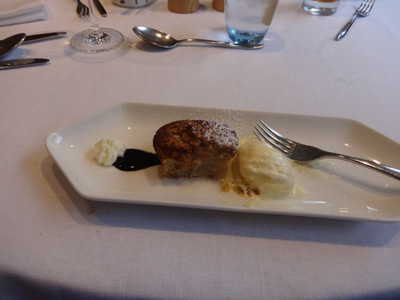 At lunch the fine-print appetizers included this small green salad and mixture of ham and cheese strips in salad dressing.
At lunch the fine-print appetizers included this small green salad and mixture of ham and cheese strips in salad dressing.
I don't remember what I had for the main course, but it was probably boeuf bourguignon.
The dessert, Chiquita banana pudding with rum raisin ice cream, was nothing like what American's would call banana puddding—it was a sort of little banana bread muffin, served warm with ice cream on top.
Along the banks, the American red oaks, which are widely planted here, are turning tequila sunrise colors. We're back in the land of red tile (and artificial red tile) roofs. Along here I saw both corrugated stle and flat beaver-tail styles. There were orchards along the banks, looking mostly like plums to me, but they were bare—late in the season I guess. Some of them were netted, but the nets were rolled up. I also saw arch-type greenhouses along the right bank, but the plastic sheeting had been taken off. Maybe they were for strawberries?

 Then it was German tea-time! German teatime was much like Viennese teatime, but the jam was apricot, the macarons were replaced with tiny palmiers, and the iced gingerbread was replaced with athree-layer concoction of crust, red bavarois, and meringue. The other sweets and the sandwiches were identical. So were the teas. No scones were ever forthcoming to go with the butter and jam. A lesson here: On teatime day, sit nearer the bow, so they don't run out of things before they get to the aft end of the lounge.
Then it was German tea-time! German teatime was much like Viennese teatime, but the jam was apricot, the macarons were replaced with tiny palmiers, and the iced gingerbread was replaced with athree-layer concoction of crust, red bavarois, and meringue. The other sweets and the sandwiches were identical. So were the teas. No scones were ever forthcoming to go with the butter and jam. A lesson here: On teatime day, sit nearer the bow, so they don't run out of things before they get to the aft end of the lounge.
While we sipped our tea, we cruised past this lovely view of a church backed by rows of vines marching up the hill to a ruined castle on top.
We also passed a facility with several barges in dry dock. Rather than being pulled up out of the water (or having the water drained from under them) perpendicular to the bank, the long, narrow barges had been loaded onto a whole series of little railroad tracks, one every few yards, and hauled up the bank sideways!
When the Niko Travel Serenade cruised by, I noticed that they have a giant chess set on their top deck.
People were fishing on the banks, some with little tents. Ducks and geese were common on the river—egyptian geese, graylag geese, mallards.
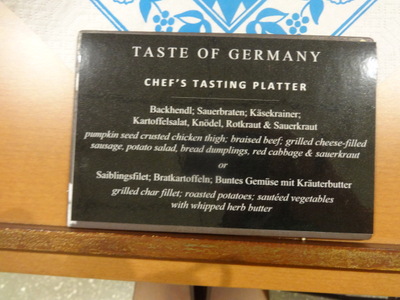
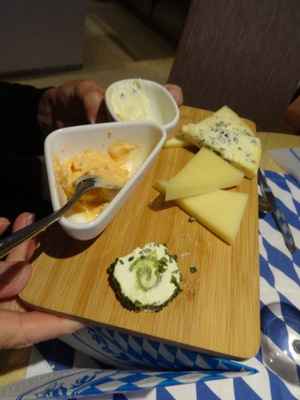 Dinner was the German Night, with blue checked tableclothes, the waitstaff all dressed up in dirndles and lederhosen, etc. At the left here is all the menu we got—identical to the German Night menu we had on our last cruise. The model was also the same. We started with appetizer boards and giant pretzels on the table.
Dinner was the German Night, with blue checked tableclothes, the waitstaff all dressed up in dirndles and lederhosen, etc. At the left here is all the menu we got—identical to the German Night menu we had on our last cruise. The model was also the same. We started with appetizer boards and giant pretzels on the table.
At the right here is the cheese board.

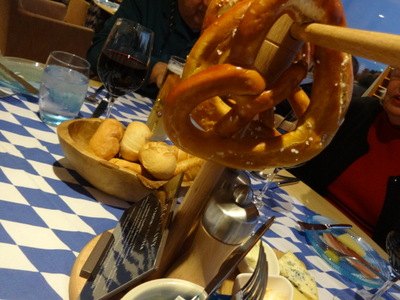 At the left here is the meat appetizer board, looking rather picked over. It started with slices of several kinds of sausages, condiments, and pickles.
At the left here is the meat appetizer board, looking rather picked over. It started with slices of several kinds of sausages, condiments, and pickles.
At the right is a shot of the giant pretzels, hanging from their special wooden rack, and a basket of bread rolls.
Next came the "chef's tasting platter" for each of us. Ours held a pumpkin-crusted chicken thigh, slab of sauerbraten, a grilled cheese-filled sausage, potato salad, bread dumplings, red cabbage, and sauerkraut. Those who preferred could have the fish version: grilled char filet with roasted potatoes, sautéed vegetables, and herb butter.
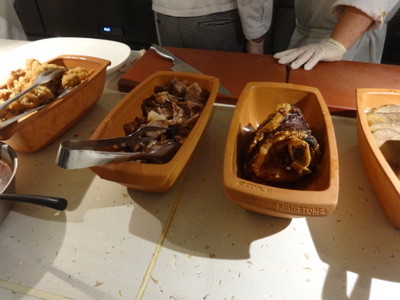
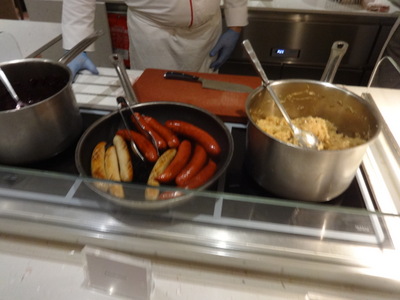
Once you'd had as much as you wanted from that plate, the buffet was open not just for more of everything you'd already been served, but for additional delicacies as well, including the crispy pork knuckle that was so exquisite on our last cruise. This one was just more of the deep-fried shoe-leather stuff—a real disappointment.
And more kinds of sausages, and a whole spätl service, with cheese, crispy fried onions, gravy, etc.
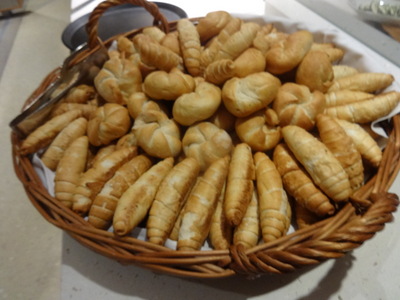
 And additional breads. At least these breads were edible, if a little tough; the ones on the last cruise were (and I'm not exaggerating here) petrified. Hard as if they were made of plaster of Paris, which perhaps they were.
And additional breads. At least these breads were edible, if a little tough; the ones on the last cruise were (and I'm not exaggerating here) petrified. Hard as if they were made of plaster of Paris, which perhaps they were.
And platters of vegetables, some raw, some sautéed, some marinated. And several kinds of mustard (not shown).

 Dessert was also buffet style. It started with platters of sliced fruit and proceeded through many, many kinds of little square pieces of cake and pastry.
Dessert was also buffet style. It started with platters of sliced fruit and proceeded through many, many kinds of little square pieces of cake and pastry.
At the right here are, for example, apple crumble, and iced gingerbread cake.
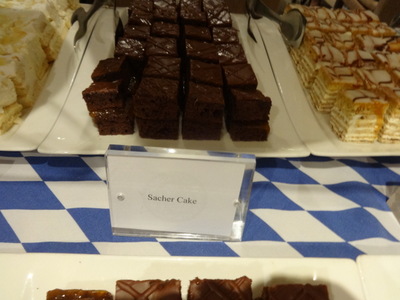
 Here are almond cream-filled cake, sachertorte cake, and what we would call Napoleons but were labeled "Esterhazy."
Here are almond cream-filled cake, sachertorte cake, and what we would call Napoleons but were labeled "Esterhazy."
Finally, it was all followed up by four flavors of ice cream and sorbet, dipped to order.
And in amongst it all, I have a photo of a half-finished bowl of soup, of which I have no recollection whatever—lost in the shuffle.
Previous entry List of Entries Next entry